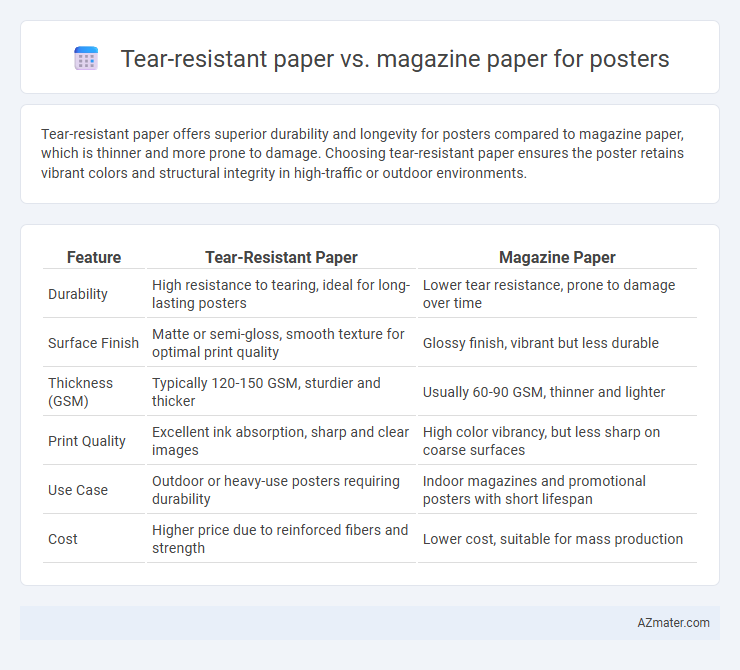Tear-resistant paper offers superior durability and longevity for posters compared to magazine paper, which is thinner and more prone to damage. Choosing tear-resistant paper ensures the poster retains vibrant colors and structural integrity in high-traffic or outdoor environments.
Table of Comparison
| Feature | Tear-Resistant Paper | Magazine Paper |
|---|---|---|
| Durability | High resistance to tearing, ideal for long-lasting posters | Lower tear resistance, prone to damage over time |
| Surface Finish | Matte or semi-gloss, smooth texture for optimal print quality | Glossy finish, vibrant but less durable |
| Thickness (GSM) | Typically 120-150 GSM, sturdier and thicker | Usually 60-90 GSM, thinner and lighter |
| Print Quality | Excellent ink absorption, sharp and clear images | High color vibrancy, but less sharp on coarse surfaces |
| Use Case | Outdoor or heavy-use posters requiring durability | Indoor magazines and promotional posters with short lifespan |
| Cost | Higher price due to reinforced fibers and strength | Lower cost, suitable for mass production |
Introduction to Poster Paper Types
Tear-resistant paper provides enhanced durability and longevity, making it ideal for posters displayed in high-traffic or outdoor areas where handling and environmental exposure are common. Magazine paper offers a glossy finish and vibrant color reproduction, suited for indoor posters that prioritize visual appeal and detail precision. Selecting between tear-resistant and magazine paper depends on the balance between durability requirements and print quality needs for specific poster applications.
What Is Tear-Resistant Paper?
Tear-resistant paper is specially engineered with reinforced fibers or synthetic additives to withstand ripping and tearing, making it ideal for posters that require durability and longevity. Unlike magazine paper, which is glossy, lightweight, and prone to tearing, tear-resistant paper offers a sturdy surface that resists wear and damage during handling or display. This durability ensures that tear-resistant posters maintain their integrity in high-traffic areas and outdoor environments.
Characteristics of Magazine Paper
Magazine paper features a smooth, glossy finish that enhances vibrant color reproduction and sharp image clarity, making it ideal for high-quality posters. It typically has a lighter weight and less durability compared to tear-resistant paper, which can result in easier creasing and tearing under stress. However, magazine paper excels in visual appeal and print detail, prioritizing aesthetics over resilience.
Durability Comparison: Tear-Resistant vs Magazine Paper
Tear-resistant paper offers superior durability compared to magazine paper, making it ideal for posters exposed to frequent handling or outdoor conditions. Its reinforced fibers resist rips and tears, whereas magazine paper typically features thinner, less sturdy material that is prone to creasing and damage. Choosing tear-resistant paper ensures longevity and maintains poster quality over time in demanding environments.
Print Quality and Color Vibrancy
Tear-resistant paper offers superior durability with a matte finish that reduces glare but often results in slightly muted color vibrancy compared to magazine paper. Magazine paper is coated and glossy, providing high print quality with sharp details and vibrant, eye-catching colors ideal for posters requiring a polished look. For long-lasting posters subjected to handling, tear-resistant paper is preferable, whereas magazine paper excels in delivering vivid visuals for short-term displays.
Cost Analysis: Budget Considerations
Tear-resistant paper typically incurs higher initial costs due to its durable materials, making it less budget-friendly for large-scale poster printing compared to magazine paper. Magazine paper offers a cost-effective solution with glossy finishes suitable for visually appealing posters but may require more frequent replacement. Evaluating long-term durability against upfront expenditure helps determine the most economical choice for poster projects.
Eco-Friendliness and Sustainability
Tear-resistant paper offers enhanced durability, reducing waste by extending the lifespan of posters compared to magazine paper, which is typically coated and less biodegradable. Magazine paper often contains higher levels of chemical coatings and bleaches that challenge recycling processes, impacting eco-friendliness negatively. Selecting tear-resistant paper supports sustainability through better longevity and improved recyclability, aligning with environmentally responsible printing practices.
Usability in Outdoor and Indoor Settings
Tear-resistant paper offers superior durability and water resistance, making it ideal for outdoor posters exposed to weather elements such as rain and wind. Magazine paper provides a glossy finish with vibrant color reproduction, enhancing visual appeal primarily for indoor use where protection from moisture and rough handling is less critical. For long-term outdoor usability, tear-resistant paper outperforms magazine paper by maintaining structural integrity and readability under harsh conditions.
Ideal Applications for Each Paper Type
Tear-resistant paper is ideal for outdoor or high-traffic environments where durability and resistance to damage are crucial, such as event posters, signage, and promotional displays exposed to weather or handling. Magazine paper, characterized by its glossy finish and high-quality print reproduction, suits indoor use where vibrant colors and fine details are essential, like fashion advertisements, art exhibits, or editorial posters. Choosing tear-resistant paper ensures longevity and toughness, whereas magazine paper optimizes visual appeal and color accuracy for professional presentation.
Conclusion: Choosing the Best Paper for Posters
Tear-resistant paper offers superior durability and longevity, making it ideal for outdoor posters or high-traffic indoor areas where handling and wear are concerns. Magazine paper provides vibrant color reproduction and a glossy finish, perfect for high-quality visual appeal but lacks the durability needed for long-term or rough use. Selecting the best paper for posters depends on balancing the need for durability with the desired visual impact and the intended display environment.

Infographic: Tear-resistant paper vs Magazine paper for Poster
 azmater.com
azmater.com